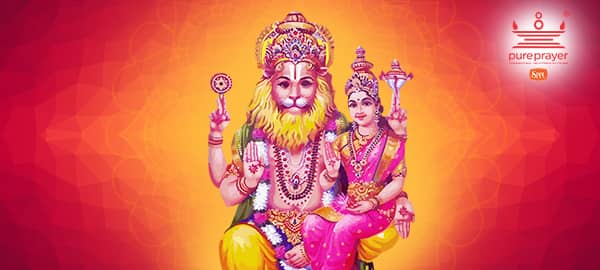UgraM veeraM MahavishnuM|
JwalantaM sarvatomukhaM||
NaarasimhaM BeeshaNaM BadraM|
Mrityur mrityuM namAmyaham||
The day of Swati Star coupled with Vaishakha Chaturdashi (Meaning: 14th day of second month in Hindu calendar) in the Shuklapaksha (bright fortnight) is celebrated as Narasimha Jayanti (Avatar of Lord Narasimha Swamy to end the tyranny of Hiranyakashipu).
Pureprayer offers warm greetings to devotees of Lord Narasimha on the day of Nrusimha Jayanti.
Devotees observe Naarasimha Vratam to propitiate Lord Narasimha Swamy. They do not partake any food after the twilight time on Chaturdashi. Devotees remain vigilant through the night without sleep and observe the day just like the day of Yekadashi (Meaning: Eleventh day in Hinduism). Pujas are performed after the day-break. Celebrations are completed with a feast, consuming food. This is called “Paarana”.
Lord Narasimha took his Avatar by breaking open the pillar at the time of twilight on that day of Swati Star coupled with Vaishakha Chaturdashi in the Shuklapaksha. He caught hold of Hiranyakashipu or Hiranya Kashyapa, who challenged Narasimha to a duel and engaged in a combat with him. He dragged the demon king to the doorstep of his palace and ripped apart his stomach using his nails and pulled out the intestines of Hiranyakashipu and gave him salvation.
Who was Hiranyakashipu?
Hiranyakashipu means ‘one clothed in gold’. Jaya and Vijaya, the guards of Vaikuntha, the abode of Lord Vishnu were once cursed by sacred quartet of sages, Sanaka, Sanandana, Sanatkumar and Sanatana. Jaya and Vijaya were born as brothers Hianyakashipu and Hiranyaksha to Sage Kashyap and his wife Diti. Hiranyaksha (Meaning: Golden eyed) was killed by Lord Vishnu in Varahavataar.
HiranyaKashyapa (Hiranya Kashipu) begets a boon by Lord Brahma that no animal nor man can kill him. He not be killed by any weapons, neither in the day nor the night. Thus, he begins a tyranny against the occupants of the universe and asking everyone to accept and serve him as a God and not Lord Vishnu.
He had five sons (Prahlad, Samhlad, Anuhlad, Shibi and Bashakal). Among these, Prahlad did not accept Hiranyakashipu’s ruling to treat him as God. Hiranyakahipu tried many ways to convince Prahlad that he was the supreme one and made mockery of Lord Vishnu. When he could not change Prahlad’s mind, he tried to kill him. Lord Vishnu took the Avatar of half human- half lion called Narasimha and put an end to the tyranny of Hiranyakashipu.
Visit Nava Naarasimha Kshetra through Spritrek
How would it be if you can take a trip which is both adventure and a spiritual journey on that sacred day and visit Nava Naarasimha Kshetra? Happiness of successful adventure and divine blessings can have no better sense of accomplishment. Pureprayer is presenting Navanarasimha under SpiRitual Journeys for those adventurous devotees who say “I do”! Please click here to learn more about taking up the visit of Naarasimha Kshetra.
Ahobilam is a very ancient Tirtha Kshetra near Cuddappah in Andhra Pradesh state and among the 108 Divyadesams. This region is believed to be the site, where Lord Vishnu broke out of the pillar to slay Hiranya Kashyapa (Hiranyakashipu). All the gods and goddesses who collected to witness the fierce battle between Lord Narasimha Swamy and the demon king Hiranya Kashyapa after he broke the pillar, were awestruck and said to have uttered these lines:
Aho veeryaM aho shauryaM aho bahuparakramaH |
NaarasimhaM paraM daivaM AhobilaM Aho balam ||
Brahmanda Purana gives the description of Narasimhavataram and protection to Prahlad the son of Hiranya Kashyapa at Ahobilam. This is the background to the name that stuck to Nallamala hills region. Here, Ahobilam implies the great cave and Ahobalam implies great strength.
The challenge is to cover all of them and many other interesting spots in the Ahobilam region in a day. With expert guidance and excellent trail plan in place, you are twice blessed taking up the SpiRitual Journeys, the spiritual adventure with Pureprayer.
Nava Naarasimha Kshetras can be divided in to Upper Ahobilam, Middle Ahobilam and Lower Ahobilam for the convenience of trekking through the region. Upper region conists of Ahobilam Narasimha, Kroda Narasimha, Jwala Narasimha and Malola Narasimha shrines. Karanja Narasimha shrine forms the middle region. The lower Ahobilam region covers the shrines of Yogananda Narasimha, Chatravata Narasimha, Pavana Narasimha and Bhargava Narasimha.
#Download #Pureprayer #App
#Android Users: https://goo.gl/ylnFgl
#iOS Users: https://goo.gl/UKvCke


Leave a review